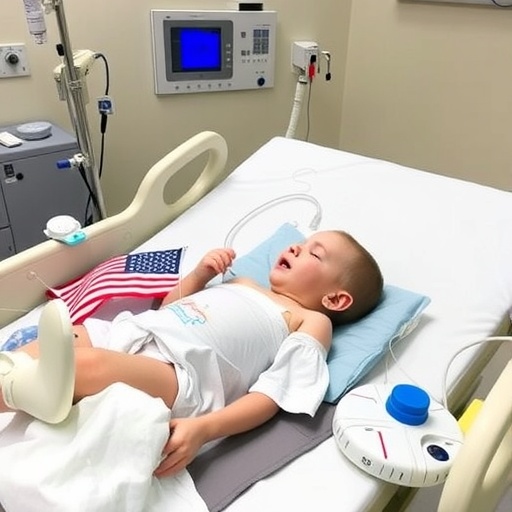In a groundbreaking medical advancement, researchers have reported the first successful implementation of a central Y–Y extra-corporeal membrane oxygenation (ECMO) system in a pediatric patient, marking a significant leap forward in the management of serious cardiac and respiratory conditions in children. This innovative methodology involves a sophisticated engineering design that could revolutionize the approach to life-threatening situations in young patients. The study, proudly published in the esteemed Journal of Artificial Organs, sheds light on the operational intricacies and clinical outcomes associated with this remarkable case.
The case centers around a pediatric patient suffering from critical cardiopulmonary failure, where traditional methods of life support were proving inadequate. The team, led by Dr. K. Tanimoto and his colleagues, aimed to provide an alternative intervention that could offer improved oxygenation and carbon dioxide removal. The implementation of the Y–Y ECMO system provides a novel approach that merges advanced technology with medical science, offering hope where conventional strategies fall short.
The Y–Y ECMO system is distinguished by its innovative design, facilitating dual blood flow pathways while optimizing oxygen delivery to the patient. Unlike traditional ECMO systems, which typically utilize a singular flow pathway, the Y–Y configuration allows for enhanced blood circulation, minimizing the risk of complications. The physiological benefits of this system could lead to a reduction in the duration of ECMO support needed, ultimately improving patient outcomes in critical care settings.
As the medical community follows this pioneering case, the implications for pediatric care are vast. Children facing life-threatening conditions often have limited therapeutic options available due to their unique anatomical and physiological characteristics. The introduction of a versatile ECMO system could expand the horizons of possibility for healthcare practitioners, allowing for more aggressive interventions that could save lives. Such advancements are crucial, as pediatric patients are often more vulnerable and require specialized care tailored to their developmental stage.
The technical details behind the Y–Y ECMO system reveal a complex interplay of biocompatible materials, cutting-edge pump technologies, and custom-engineered circuit configurations designed to accommodate the smaller vascular systems of children. This design philosophy ensures that the blood flow characteristics remain stable while minimizing hemolysis and reducing potential thromboembolic risks. The intricate placement of the system components requires meticulous planning, highlighting the collaborative efforts of surgeons, perfusionists, and critical care specialists.
Importantly, the study also addresses the ethical considerations accompanying the use of advanced ECMO systems. In the face of critical care interventions, family discussions regarding prognosis, potential quality of life, and long-term health impacts become paramount, especially in pediatric cases. The team emphasized the importance of transparent communication with families to facilitate informed decision-making in desperate circumstances, ensuring that the valorization of life is matched by a compassionate approach to care.
Furthermore, this singular case sets the stage for future research endeavors aimed at refining ECMO technologies for pediatric applications. The potential for multicenter trials and collaborative studies could offer deeper insights into the long-term efficacy and safety of the Y–Y ECMO system. Analyzing data from subsequent cases may yield valuable information that could inform standard protocols and practice guidelines across diverse healthcare settings.
As we consider the broader implications of this study, it becomes clear that the advent of specialized ECMO systems represents not just a technological breakthrough, but a profound shift in how we approach pediatric care. The findings may inspire the creation and assessment of future interventions, enabling a more nuanced understanding of respiratory and circulatory support in vulnerable populations.
In the wake of this pioneering case, a number of pertinent questions arise regarding the scalability of the Y–Y ECMO system. Can this system be manufactured at a cost-effective rate for broader application? Will variations of this technology emerge to address other specific medical challenges? These inquiries pave the way for further innovation in the design and application of extracorporeal life support technologies, promising a future rich with possibilities for equally transformative medical interventions.
Every patient is unique, and their responses to treatment can vary significantly. The introduction of the Y–Y ECMO system calls for a multi-faceted evaluation process that captures individual patient characteristics and clinical pathways. The field of pediatric critical care must remain agile and responsive to arising data, ensuring that performance metrics are established and revised to promote continuous improvement in patient care.
In summation, this inaugural case of the Y–Y ECMO in a pediatric patient embodies the essence of medical advancement—transformative technologies grounded in compassionate care. As practitioners worldwide embrace these emerging techniques, the ultimate goal remains steadfast: to enhance the survival chances and quality of life for children facing devastating health challenges.
Through diligence, innovation, and a commitment to patient-centered care, the medical community can propel forward, with the Y–Y ECMO system marking just the beginning of a new era in pediatric life support.
Subject of Research: Implementation of central Y–Y extra-corporeal membrane oxygenation system in pediatric patients.
Article Title: The first case of central Y–Y extra-corporeal membrane oxygenation system in a pediatric patient.
Article References:
Tanimoto, K., Iwai, S., Komori, M. et al. The first case of central Y–Y extra-corporeal membrane oxygenation system in a pediatric patient.
J Artif Organs 28, 468–472 (2025). https://doi.org/10.1007/s10047-024-01490-8
Image Credits: AI Generated
DOI: https://doi.org/10.1007/s10047-024-01490-8
Keywords: ECMO, pediatrics, life support, Y–Y system, critical care.




